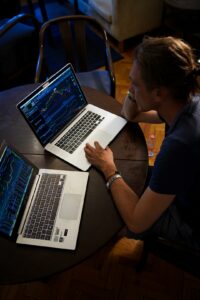The Forex market is a decentralized global marketplace where various currencies are traded. With a daily turnover of over $6 trillion, it is the largest and most liquid financial market in the world. Unlike other financial markets, Forex operates 24 hours a day, five days a week, allowing traders to take advantage of overlapping trading hours.
Understanding the Forex Market Time
The Forex market is open for trading from Monday morning in Australia to Friday evening in New York. This 24-hour market is divided into four major trading sessions: the Sydney session, the Tokyo session, the London session, and the New York session. These sessions overlap at certain times, creating periods of high liquidity and increased trading opportunities.
Sydney Session:
The Sydney session starts at 10 PM GMT and ends at 7 AM GMT. It is considered the least volatile of all the sessions, with relatively lower trading volumes. However, this doesn’t mean there aren’t any profitable opportunities during this time.
Traders can take advantage of the Sydney session by focusing on currency pairs involving the Australian dollar (AUD), New Zealand dollar (NZD), and Japanese yen (JPY). Economic news releases from Australia and New Zealand can have a significant impact on these currency pairs, making them more volatile during this session.
Tokyo Session:
The Tokyo session begins at 12 AM GMT and lasts until 9 AM GMT. This session is known for its high liquidity, as it overlaps with the Sydney session for a few hours. During this overlap, traders can expect increased trading volumes in AUD/JPY, NZD/JPY, and AUD/NZD currency pairs.
The Tokyo session is also influenced by economic news releases from Japan, which can lead to volatile price movements in JPY pairs. Traders should keep an eye on the Bank of Japan’s monetary policy decisions and economic indicators such as GDP and inflation data.
London Session:
The London session is widely regarded as the most important session in Forex trading. It opens at 8 AM GMT and closes at 5 PM GMT. This session overlaps with both the Tokyo and New York sessions, resulting in the highest trading volumes and volatility.
During the London session, major currency pairs such as EUR/USD, GBP/USD, and USD/JPY see significant price movements. Economic news releases from the Eurozone and the United Kingdom can greatly impact these currency pairs. Traders should monitor events like interest rate decisions, GDP reports, and employment data during this session.
New York Session:
The New York session starts at 1 PM GMT and ends at 10 PM GMT. It overlaps with the London session for a few hours, creating a period of increased liquidity. The major currency pairs, such as EUR/USD, GBP/USD, and USD/JPY, experience high trading volumes during this overlap.
Traders should pay attention to economic news releases from the United States, as they can cause significant price fluctuations in USD pairs. Key economic indicators to watch include non-farm payrolls, consumer price index (CPI), and Federal Reserve policy decisions.
Taking Advantage of Overlapping Trading Hours:
The overlapping trading hours between different sessions offer traders unique opportunities to profit. These periods are characterized by increased liquidity, higher trading volumes, and potentially greater price movements.
One strategy that traders can employ during overlapping sessions is called “breakout trading.” Breakout trading involves identifying key support and resistance levels and waiting for a breakout to occur. Traders can use technical indicators, such as moving averages or Bollinger Bands, to confirm a breakout.
Another strategy is “range trading,” which involves identifying currency pairs that are trading within a defined range. Traders can buy at the lower end of the range and sell at the upper end, aiming to profit from the price bouncing between these levels.
It’s important to note that while overlapping trading hours offer increased trading opportunities, they also carry higher risks. The increased volatility can lead to larger price swings and potential losses. Traders should always use proper risk management techniques, such as setting stop-loss orders and limiting their exposure to any single trade.
In conclusion, taking advantage of overlapping trading hours in the Forex market can provide traders with increased liquidity and potential profit opportunities. By understanding the characteristics of each trading session and employing appropriate trading strategies, traders can maximize their chances of success in this dynamic and exciting market.






